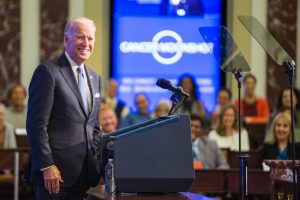United States Rejoins the Paris Agreement
 Today, the United States has officially rejoined the Paris Agreement. Following United Nation rules, that’s 30 days after a letter from President Joe Biden the day of his inauguration stating his decision for America to immediately re-join the global accord. That’s good news, the implications of which were made clear by Dr. Robert Kay of ICF Consulting in a recent webinar.
Today, the United States has officially rejoined the Paris Agreement. Following United Nation rules, that’s 30 days after a letter from President Joe Biden the day of his inauguration stating his decision for America to immediately re-join the global accord. That’s good news, the implications of which were made clear by Dr. Robert Kay of ICF Consulting in a recent webinar.
The Paris Agreement was adopted by 195 countries in 2015 following the 21st United Nations Conference of Parties in Paris (COP 21). The Agreement commits nations to work together to limit global average temperature rises by 2 degrees C, and to pursue a lesser 1.5 degree rise. Signatories are responsible to submit Nationally Declared Commitments (NDCs) that state their goals and plans.
A brief review: The United States signs the Agreement in 2015. The Agreement was ratified by the U.S. Congress in 2016. Former President Trump pulls the U.S. out of Paris in 2017.
Then “non-federal actors” took over. Out of necessity, climate action shifted from the federal level to states, local governments, NGOs (non-governmental organizations, non-profits), and to the private sector. We Are Still In was formed. It is now made up of over 3,900 CEOs, mayors, governors, county executives, faith leaders, tribal leaders, college presidents, health care organizations, and others who have pledged to continue strive for the Paris Agreement goals.
Three governors – Cuomo, Brown, and Inslee – forged the U.S. Climate Alliance in 2017 to carry on America’s work with climate protection. By the end of 2020, there were 25 states in the Alliance representing 60% of the U.S. population. These states are reducing greenhouse gas (GHG) emissions faster than the national average rate, and their economies have grown slightly larger than average.
The cooperation of these states in building markets for low-carbon products and services has been significant. Hydro-fluorocarbons are refrigerants, but also potent GHG gases. The Climate Alliance states took on HFC regulation when it was “vacated” by the Trump administration. The Climate Alliance has been making progressive policies the norm: Now there are 16 states with 100% renewable energy goals… unthinkable just a few years ago. They are forming good jobs in clean energy and energy efficiency, providing multiple job pathways in the climate sector.
President Biden recommitted the United States to the Paris Agreement through Executive Order on his first day in office, January 20, 2021. Now the federal government shifts from climate protection adversary to ally. According to Julie Cerqueria, Executive Director of the U.S. Climate Alliance, “There has been a complete sea change.”
The states have built a strong foundation for the fed now to build upon. President Biden’s Executive Order also established the Office of Domestic Climate Policy. It also calls for the creation of the Climate Corps reminiscent of Franklin Delano Roosevelt’s Civilian Conservation Corps, and a little later the Student Conservation Corps formed in the 1950s and going strong.
The Biden administration plans to release the new Nationally Declared Commitment on Earth Day, April 22, 2021. According to Rob Kay and his colleagues at IFC, the United States must demonstrate global leadership, but its plan must also be do-able. The first U.S. NDC called for reducing emissions by 25 – 28% by 2025 from a 2005 baseline. Biden is being pressured to up the ante and to cut emissions by 50% by 2030, and to achieve neutrality mid-Century. We’ll stay tuned.
